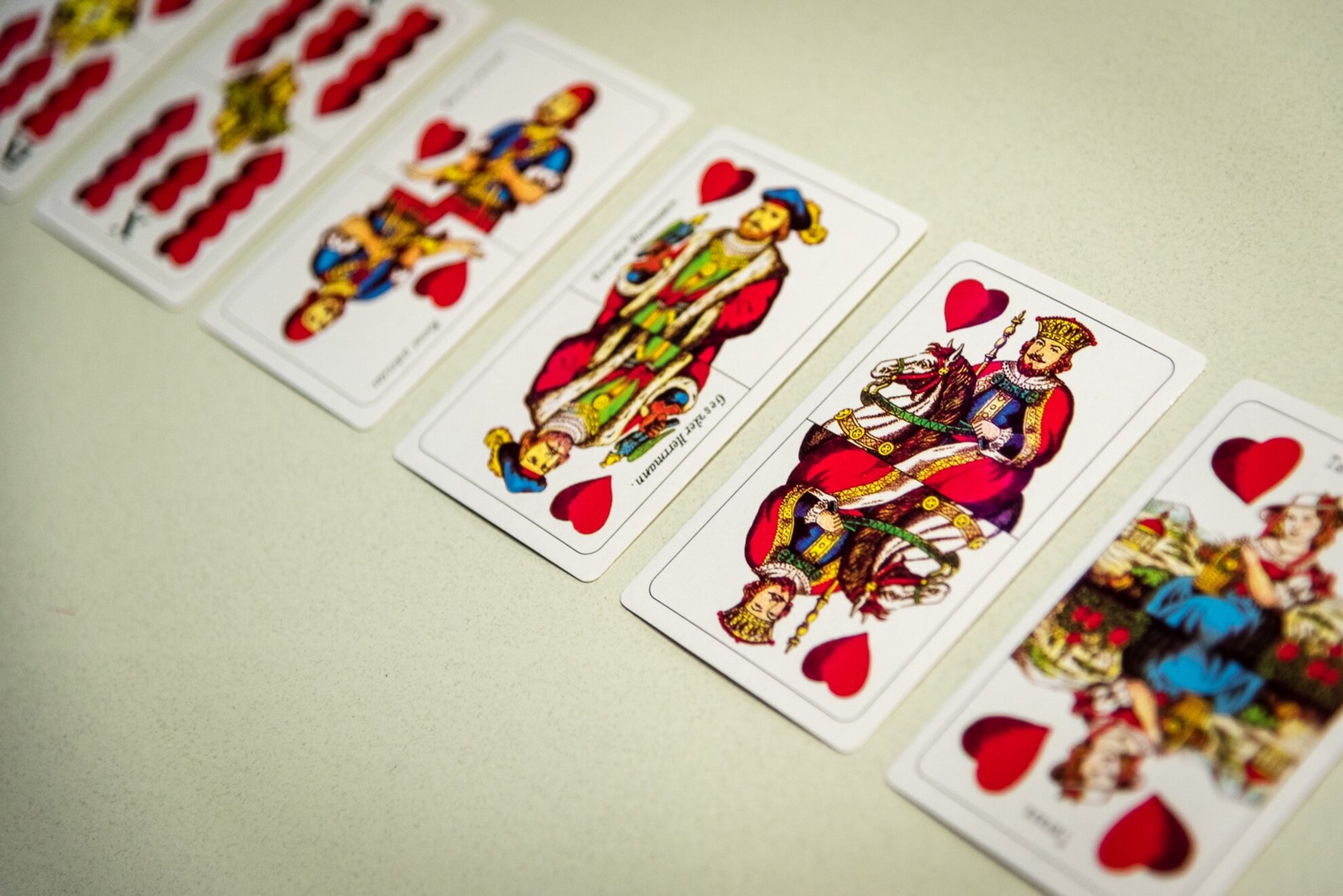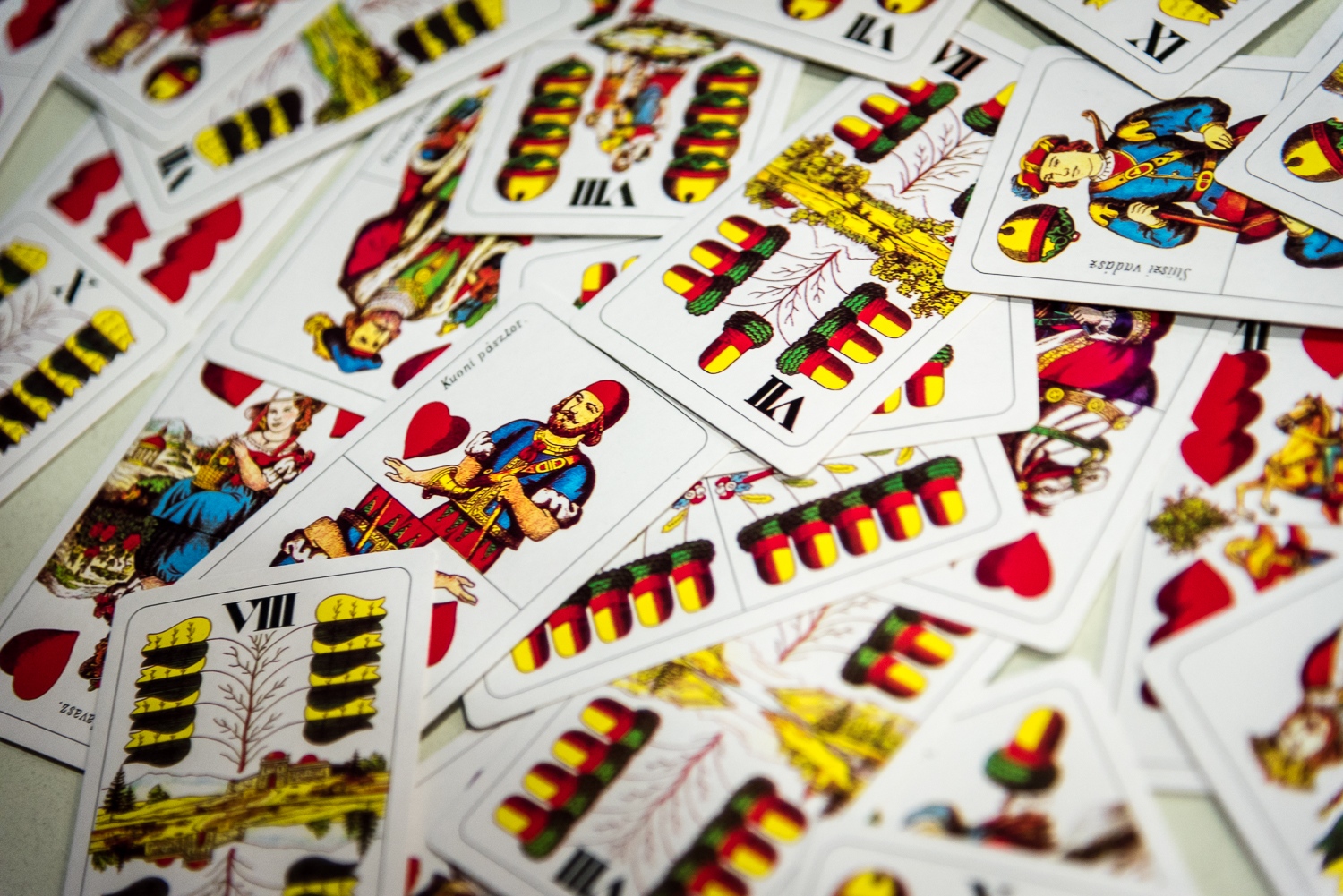Unlike standard playing cards, a Hungarian deck – called “Magyar kártya” – consists of only 32 cards, divided into four suits: acorns, hearts, leaves, and bells. (Magyars call the leaves ‘zöld’, meaning ‘green’ in Hungarian; and the bells ‘tök’, meaning ‘pumpkin’). The suit symbols are derived from the original German playing deck, which has been around since the early 15th century, with the suits symbolizing the four main layers of society: hearts (or ‘red’) are the clergy, leaves are the citizens, acorns are the peasantry, and bells represent nobles. The cards are numbered with Roman numerals from VII-X ( in some varieties from VI-X), followed by under and upper knaves, kings, and aces.

The under and upper knaves feature figures from the Swiss legend of William Tell. The sharpshooting hero himself is found on the upper knave of acorns, while his enemy, the tyrant Herman Gessler, is depicted on the upper knave of hearts. Some characters on the numbered cards are lesser-known figures from the drama, and there is no certainty over why these specific characters were selected to supplement the cards. The four anonymous kings are mounted on horseback, while the four aces depict the four seasons, with patterns evoking the most characteristic qualities of all four sets of months. On some other cards we can see special scenes from William Tell, such as the tyrant’s hat hung on a post on 9 of Bells, and Tell’s family bidding farewell to him on 8 of Bells.

The inventor of Hungarian cards is considered to be József Schneider, a Magyar card painter who is said to have designed the first deck of cards sometime in the 1830s in Budapest, when a revolutionary spirit started spreading through Europe against authorities; this movement later escalated into the Spring of the Nations in 1848, a series of political upheavals across the continent. At those times, dissatisfaction against the Habsburg Dynasty’s rule in Hungary started strengthening, and a revolutionary spirit fueled the country’s young intellectuals. According to the most likely hypothesis as to why there are Swiss heroes on the Hungarian cards, when Friedrich Schiller’s dramatic version of William Tell first played in Hungary in 1827, it inspired the card painter to encourage the rebellious spirit by depicting the heroes of a successful imaginary revolt against the Habsburgs, instead of using the real Magyar leaders of the revolution, thus avoiding any trouble with censorship and the government.

The cards were completed by the time of the Hungarian Revolution of 1848, and have been widely used for various card games across the country ever since. By the late 19th century, these playing cards became a beloved free-time activity of the masses, and the name “Hungarian cards” became widely popular in the 20th century. December 29th – the day when a commemorative plaque was placed on today’s Wichmann Pub in Kazinczy Street, the former house of József Schneider – is named “Hungarian Cards Day”.
Some Hungarian card games
Csapd le Csacsi! (rough translation: “Drop it Donkey!”)Players:2-4The game: All players are dealt 8 cards. The game proceeds clockwise, and the objective is to collect all 8 cards of a certain suit. The first player ‘sends’ a card to their right-hand neighbor without showing the card to anyone, and then the player who received the card sends one to their neighbor, and the game goes round and round, until the first person with all 8 cards of the same suit drops their cards on the table. The last player to do so is the donkey.

Piros Papucs (rough translation: “Red Flipflops”) Players: 3-6 The game: The cards are all arranged face-down in a circle, and one single card is flipped over and placed in the middle of the circle. The first player has to draw cards from the circle until they find one that matches the suit of the card in the middle. When they find one, they place it on top of the card in the middle, and request another suit from their right-hand neighbor, who also draws cards from the circle until they find one of that requested suit, and so on. In case a player doesn’t have the suit requested by their neighbor in their hand, and there are no more cards in the circle, they have to draw a card from the middle pack. The aim is to get rid of all your cards after there are no more cards in the initial circle.

Makaó (Macau) One of the most popular Magyar card games, Makaó, is much like the widely known Uno.
Players:2-4
The game: The objective is to be the first to get rid of all the cards in your hands. In the beginning, each player gets 5 cards, and the rest of the deck stays on the table. The dealer flips the top card of the deck, and then the game proceeds clockwise starting with the player next to the dealer. Each player either plays a card (or multiple cards) that matches the suit or number of the top card, or has to draw one from the deck. If a player has only one remaining card in their hands they have to say “makaó” (macau), or else they’ll have to draw two cards from the deck as a penalty. As Makaó has various variations even in Hungary, you can invent your own rules for certain ‘action cards’ and say, for example, that if someone plays a 2, the next player has to draw 2 cards, and so on.
Learn more about Hungarian games on this website.




